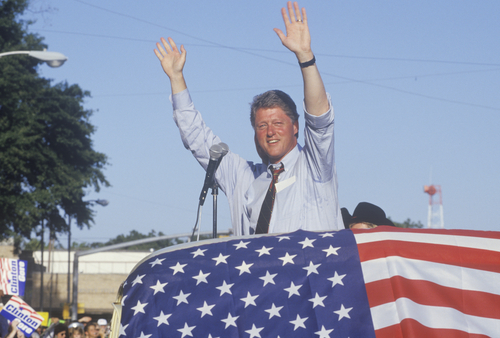
So, how did America’s poor fare under Bill Clinton’s White House reign? Better than George W. Bush — at least that seems to be the common belief among Democratic voters today, especially those lining up behind Madam Hillary. However, the economy under Clinton in the 1990s may not have been as robust and healthy as many would like to believe.
As economist Robert Pollin of the University of Massachusetts at Amherst explains in Contours of Descent: US Economic Fractures and the Landscape of Global Austerity, Clintonomics was not all it was cracked up to be. “The distribution of wealth in the US became more skewed than it had at any time in the previous forty years,” he argues. “No question, an increasing number of US jobs began to be outsourced at an unprecedented rate as well.”
“Unlike Clinton, Bush is unabashed in his efforts to mobilize the power of government to serve the wealthy,” he continues. “But we should be careful not to make too much of such differences in the public stances of these two figures, as against the outcomes that prevail during their terms of office … the ratio of wages for the average worker to the pay of the average CEO rising astronomically from 113-to-1 in 1991 under Bush-1 to 449-to-1 when Clinton left office in 2001.”
Pollin points out that while Clinton’s tax policy reversed some of the regressive taxation that occurred under Ronald Reagan, it certainly did not reverse the brunt of it. And, as Pollin contends, “The fact is that, insofar as the end of the Cold War yielded any peace dividend under Clinton, it took the form of an overall decrease in the size of the federal government rather than an increase in federal support for the programs supposedly cherished by Clinton, such as better education, improved training, or poverty alleviation.”
Was Clintontime even a boom-era after all? Pollin doesn’t think so. “Under the full eight years of Clinton’s presidency, even with the bubble ratcheting up both business investment and consumption by the rich average real wages remained at a level 10 percent below that of the Nixon-Ford peak period, even though productivity in the economy was 50 percent higher under Clinton than under Nixon and Ford. The poverty rate through Clinton’s term was only slightly better than the dismal performance attained during the Reagan-Bush years.”
Bargaining power for low-wage workers during the 1990s decreased tremendously as well. Wall Street scion Alan Greenspan in fact did not want the unemployment rate to drop below 6 percent because he feared that inflation would skyrocket. Greenspan also did not want workers to increase their bargaining power, which could possibly benefit their organizing strength in the work place. The majority of workers during Clintontime were not happy with their occupations. As Pollin writes, “Wage gains for average workers during the Clinton boom remained historically weak, especially in relationship to the ascent of productivity. These facts provide the basis for the poll findings reported in Business Week at the end of 1999 that substantial majorities of US citizens expressed acute dissatisfaction with various features of their economic situation.”
Pollin also shows that the Earned Income Tax Credit (EITC), the most significant economic initiative under Clinton, more than doubled from $9.3 billion to $26.8 billion during Clinton’s first two terms. But food stamps “dropped by $8.5 billion reflecting a large increase in the percentage of households who are not receiving food assistance even though their income level is low enough for them to qualify. Under the Clinton Administration, the decline in the number of people receiving food stamps — 9.8 million — was 17% greater than the decline in the number of people officially defined as impoverished and was accompanied by a dramatic increase in the pressure on private soup kitchens and food pantries.
“And while the EITC does correct some of the failings of the old welfare system, it has created new, and equally serious, problems. Moving poor and unskilled women from welfare onto the labor market exerts a downward pressure on wages, and the national minimum wage itself is too low to allow even a full-time worker to keep just herself and only one child above the official poverty line.”
Poverty did decline under Clinton by almost 4 percentage points. Yet, as Pollin explains, in the prosperity of the 1990s, this small drop back to 1974 levels is reprehensible: “Per capita GDP in 2000 was 70% higher than it was in 1974, productivity was 61% higher, and the stock market was up 603%.”
Clinton’s presidency did see a stop in wage decline from 1993 to 1996, however. And in the next three years wages rose sharply. But “the real wage gains were also, in turn, largely a result of the stock market bubble. The Clinton economy of the late 1990s, whose successes were so heavily dependent on the stock market, offers little guidance as to what such an alternative path to sustained improvements in real wages might be.
“Moreover, conditions under Clinton worsened among those officially counted as poor. This is documented through data on the so called ‘poverty gap,’ which measures the amount of money needed to bring all poor people exactly up to the official poverty line. The poverty gap rose from $1,538 to $1,620 from 1993-99 (measured in 2001 dollars).”
Pollin continues, “Because workers had experienced the ‘heightened sense of job insecurity’ under most of Clinton’s tenure, when wages did finally start to rise significantly in 1997, this was from an extremely low base. Moreover, the injection of increased spending under Clinton that produced low unemployment came from the stock market bubble, which, as has now become transparently clear, was unsustainable. In the 1960s, the catalyst driving the economy to full employment was government spending on the Vietnam war — that is, a source of economic stimulus that was also unsustainable and even more undesirable than the 1990s market bubble.
“The central challenge for an employment-targeted policy in the US today would therefore be to identify alternative sources of job expansion that do not require waging war or destabilizing the financial system. The Bush-2 plan for huge military spending increases obviously does not qualify any more than the Vietnam War as a desirable source of job expansion.”
In other words, even though jobs were plentiful in the 1990s, poverty was widespread and, if fact, increasing. All this before the effects of NAFTA and welfare reform reared their ugly heads. But this was all by design. Clinton, et al., knew exactly what it was they were doing. No question Hillary’s neoliberal agenda will follow suit.
